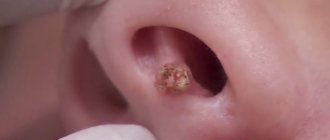Dried crusts of blood in the nose are not a rare occurrence. The phenomenon occurs in both adults and children. There can be many reasons: from a common runny nose to serious problems with blood vessels. The appearance of crusts of blood in the nose is not a disease, but it indicates problems in the body. How dangerous this is depends on how often the symptom occurs.
Don't underestimate the problem. After all, without proper treatment, bloody plaques in the nose can lead to atrophic changes in the mucous membrane. In the future, chronic diseases of the entire nasopharynx and respiratory tract may develop. Therefore, if you notice that blood is caked in your nose, it is important to determine the cause of this phenomenon.
Taking medications
Dried blood in the nose can occur after the flu and ARVI. In most cases, this becomes a negative reaction of the body to vasoconstrictor drugs for the common cold. Most sprays and drops have a drying effect on the mucous membrane. The instructions for use indicate the maximum number of days of use of the medicines.
Even compliance with the treatment regimen often leads to adverse reactions of the mucous membrane and disruption of the blood vessels.
Hormonal drugs used to treat diseases can also have a strong effect on the condition of the nasal vessels In this case, the doctor must determine the degree of danger of using medications.
To ensure that nasal medications do not cause harm, use them with caution and read the instructions carefully
Why does blood bake in the nose?
There are people who suffer from the constant appearance of bloody crusts in their nose.
They are already so used to it that they don’t care why there are bloody boogers in their nose. However, you should be wary if, despite a thorough daily toilet, they still continue to form. If this problem occurs several times in a row, you should consult a doctor.
After all, blood in the nose can signal the presence of a serious problem in the body.
Ignoring this problem and the lack of proper treatment will sooner or later lead to the nasal mucosa completely atrophying. And then more discharge with pus, pain in the bridge of the nose and other unpleasant symptoms will be added. To understand why both blood crusts form in the nose and the discharge with fresh blood that precedes them, you need to know the reasons for this phenomenon.
Symptoms
The main symptom is excessive dryness of the mucous membranes. And the appearance of pieces of dried blood is accompanied by an unpleasant (sometimes even fetid) odor and a significant amount of crusts due to improper nasal hygiene. The most common symptom is difficulty breathing through the nose. It is complemented by a complete loss of smell or a sudden decrease in it.
At the very beginning, when crusts of dried blood in the nose are just about to form, the inferior turbinate atrophies. This destructive process then affects the walls of the nasal passages. At the same time, their cavities expand significantly.
During the rhinoscopy procedure, the doctor clearly sees dried tissue in both nasal passages, consisting of dark brown or yellow-greenish crusts. It even covers the nasopharynx (more precisely, its back wall). Often, when these crusts begin to dry out, they cover the entire mucous membrane in the nose with a dense shell. Thus, the nasal passages are filled almost completely.
After removing the blood crusts, the clean cavities of the nasal passages become wider. But the mucous membrane is covered in places with a thick yellow-greenish exudate.
Where does dried blood come from in the nose?
When considering the causes of drying blood in the nose, first of all, you need to understand why the capillaries are damaged. After all, it is from them that blood enters the nasal passages, turning over time into those same dried crusts.
- Living conditions. The main factor that causes blood to enter the nose is dry air. If the humidity level in the room is extremely low, you can assume that you have established where the blood comes from when you blow your nose. The effects of excessively dry air can most often be felt in winter - when the heating season is in full swing, in production, as well as in some climatic zones. Especially if a person’s stay in this zone is short, the body simply does not have time to adapt. The nasal mucosa begins to dry out rapidly, as a result of which the capillaries can be damaged.
- Taking medications. Frequent use of topical medications for the common cold can also cause crusts of dried blood to appear in the nose. Many nasal sprays and drops that are used to relieve nasal congestion dry out the nasal mucosa. And this adversely affects the condition of the capillaries. To avoid such an unpleasant side effect, you should use special means to combat the runny nose strictly for medical reasons. It is also recommended to alternate the use of these products with moisturizing the mucous membrane with any vegetable oil of your choice.
- Diseases of the nasopharynx. Most often we are talking about sinusitis. When the mucous membrane becomes inflamed, minor bleeding occurs, the cause of which is damage to the capillaries. Visually, this is expressed in crusts of dried blood in the nasal passages.
- Diseases of the cardiovascular system. High blood pressure often provokes heavy nosebleeds. However, sometimes very little blood is released. And it is detected only in the form of baked pieces during blowing of the nose or hygienic cleaning of the nose. An indication that the cause of blood clots is precisely hypertension is the fact of a pressure surge, after which these clots are observed. It is also advisable to check the condition of the blood vessels if signs of bleeding from the capillaries are visible in the morning, after waking up. Take into account the level of humidity in the bedroom - it should be normal.
- Connective tissue problems. They can be caused by autoimmune diseases (pathological conditions that occur when the body's immune system produces antibodies to its connective tissue). As you know, capillaries and other vessels consist of connective tissue. That is why one of the symptoms of vasculitis, systemic lupus erythematosus, Sjogren's syndrome and a number of other autoimmune diseases is damage to the walls of the capillaries in the nose. Therefore, traces of dried blood are observed in nasal secretions.
Diagnosis and treatment methods
The first step towards eliminating such a nuisance as clots of dried blood in the nasal passages is an accurate diagnosis. If you expect quick and successful treatment, it must be timely.
The doctor makes a diagnosis based on the following symptoms: the presence of a bad smell from the nose, many blood crusts, as well as pronounced atrophy of the inner wall of the nasal cavity and the mucous membrane lining the nasal passages.
Most often, clots of dried blood in the nose accompany acute laryngitis and pharyngitis. In rare cases, they are accompanied by tracheitis.
If you regularly pull out dried blood when cleaning your nose, this should prompt you to visit a specialist. The doctor will perform a rhinoscopy - an examination with which it will be possible to find out the specific cause of the appearance of dried crusts. When, during the examination, some congenital or acquired pathology is discovered, the issue of correcting it can be decided.
So, as already mentioned, you can successfully get rid of blood crusts only when the diagnosis was made in a timely manner. If the causes of the identified disease are not related to tissue atrophy, then the patient is treated with conservative methods. The following procedures are often prescribed:
- organ therapy - to restore the normal functioning of the nasal mucosa;
- phytodynamic therapy - after the mucous membrane is restored, it is necessary to maintain and consolidate its performance;
- irrigation (necessarily fine) using mineral solutions;
- acceleration of lymph flow - to resume excretory function;
- inophoresis - to restore normal tissue activity;
- nasal rinsing and irrigation (prescribed if the cause of the formation of blood crusts is simply dry mucous membranes).
The question arises: is it possible to somehow solve this problem on our own, without resorting to the help of doctors? Of course you can. First of all, you need to constantly monitor the level of air humidity in the room where you spend most of your time.
To moisturize the nasal mucosa and heal it, you can use a variety of ointments (it is best to choose those that also have a disinfecting effect). However, if you have already tried everything possible, and crusts of dried blood still appear in your nose, it is recommended to visit an experienced otolaryngologist.
Let's summarize
If suddenly, when you blow your nose, you discover a bloody pellet, you shouldn’t panic right away. Observe nasal discharge for several days. If dried blood in the nasal passages appears daily, you should consult an otolaryngologist. He will conduct the necessary examinations to exclude (or confirm) pathological conditions.
In most cases, this problem can be easily resolved. However, if you have any congenital pathology, or irreversible atrophic degeneration of the mucous membrane has begun, it is undesirable to delay visiting a doctor. After all, the formation of blood crusts signals that atrophy of the mucous membrane is already developing.
Therefore, treatment will have to be done under the guidance and supervision of a specialist. In this case, it is extremely important to promptly and correctly determine the causes of the problem. A correct diagnosis significantly increases the chances of recovery.
Yulia Zablotskaya
Source: https://lorcabinet.ru/bolezni-nosa/vavki/prichiny-zapekshejsya-krovi.html
Diseases of the nasopharynx
Frequently recurring and chronic rhinitis (bacterial or allergic) affects the mucous membrane and causes dryness and irritation in the nose. If itching or burning occurs, you should contact an ENT specialist immediately. Irreversible changes in the structure of the mucous membrane and the development of chronic diseases of the nasopharynx are possible.
Diseases of the cardiovascular system
High blood pressure can cause systematic rupture of blood vessels in the nose and the appearance of crusts. It is mistakenly believed that nosebleeds lead to decreased blood pressure.
According to doctors, the appearance of minor nasal hemorrhages is a dangerous symptom of hypertension or intracranial hypertension.
High blood pressure may cause nasal crusting to fail treatment
The blood vessels in the nose are distinguished by particularly thin walls and close proximity to the surface. That is why they rupture during periods of increased blood pressure.
Snot with blood in an adult
Common symptoms that accompany the appearance of bloody snot in an adult include headache, severe migraine and elevated body temperature. In this way, symptoms of sinusitis, sinusitis and frontal sinusitis may appear.
To better understand what the essence is, let's look at the clinical picture, which may look like this - inflammation of the nasal sinuses can lead to thinning of the walls of blood vessels. Thus, when blood appears in the snot, doctors recommend wiping the inside of the nostrils with hydrogen peroxide (3%) using a cotton swab or swab.
If the cause of snot with blood is dry air in the room, it is recommended to moisturize the nose from the inside with tea tree oil, which, moreover, perfectly prevents harmful microbes, viruses and dust from entering the body.
To finally deal with this problem, you still need to see a specialist, because snot with blood often signals that it is necessary to strengthen the entire cardiovascular system. You can get the necessary advice on this issue from an otolaryngologist.
Other reasons
During adolescence, children experience hormonal changes in their bodies . Therefore, from time to time, nosebleeds may occur, which disappear with the stabilization of hormonal levels.
In older people, crusts in the nose may occur due to age-related changes associated with degeneration of the mucous membranes.
Dried blood in the nose in the morning may indicate excessive physical activity the day before and lack of rest at night.
With severe overwork, sudden jumps in blood pressure are possible, which provoke nosebleeds.
Dried blood in the nose
The appearance of blood clots with snot is a very frightening phenomenon. Sometimes it can indicate the presence of serious medical illnesses, and in some cases it is associated with a harmless cause.
I would like to immediately note that there is a big difference between snot with blood and bleeding.
In the first case, this condition occurs sometimes and the amount of blood is insignificant, but bleeding requires qualified help.
Snot with blood is not a disease, but only a symptom indicating the presence of some kind of pathology. Thus, weakened immunity can lead to a decrease in the strength of the walls of blood vessels. A cold or even pregnancy can help activate this process. Blood can dry out in the nose and then come out along with mucous secretions when you have a runny nose.
Why does blood appear in the nose?
You should not fight the symptom itself, since it is a consequence, but the cause of its occurrence. Otherwise, the disease will take on a latent, chronic form and getting rid of it will become much more difficult. The causes are mostly divided into physiological and pathological.
Physiological reasons
The effect of physiological causes is short-term; usually they do not require the help of a doctor, but disappear on their own. Let's highlight the main reasons:
- seasonal vitamin deficiency;
- poisoning;
- bad habits;
- environmental factor;
- harmful working conditions.
If the cause of blood in the nose is not eliminated, the symptom will return again and again.
In case of physiological reasons, the following actions can help:
- ventilation of the room;
- purchasing an ionizer or humidifier, especially in cases where blood constantly dries out in the nose;
- rinsing the nasal cavity with herbal decoctions or wound healing solutions;
- lubricating the nose with Vaseline;
- to normalize blood circulation, do special gymnastics;
- taking a decoction of a plant to strengthen blood vessels: nettle or rose hips.
Pathological causes
Let us highlight the main pathological factors of dried blood:
- persistent cold;
- ARVI;
- sinusitis;
- increased intracranial pressure;
- tuberculosis;
- papillomatosis;
- disorders of the coagulation system.
The capillary walls of the nasal mucosa in children are at the stage of formation, so the appearance of blood in them is more common than in adults. Even the slightest damage can cause symptoms to appear.
https://www.youtube.com/watch?v=r29_73njvBA
Let's highlight the main reasons:
- injury;
- fragility of blood vessels due to lack of vitamin C;
- dry nasal mucosa;
- viral infections;
- intracranial pressure;
- physical exercise or a change in climatic conditions can provoke short-term vascular spasm.
It is quite difficult to identify the true cause in childhood, as the child cannot describe his complaints. Therefore, you should not engage in self-diagnosis, and if alarming symptoms appear, consult a doctor.
Even minor injuries can cause nosebleeds in children.
Bloody nose can be a very frightening symptom, especially if it occurs for the first time. Indeed, in some cases, blood is baked due to serious illnesses. Damage to the mucous membrane of the nasal cavity is perhaps one of the most common causes of this symptom.
The mechanism of this pathological process is quite simple: the capillaries burst, resulting in their contents flowing into the nose. Due to the fact that the release of blood from the capillaries is insignificant, it dries quickly. A person usually discovers it when blowing his nose or washing his nose.
Living conditions
Why does my nose bleed in the morning?
Dry air is the main cause of blood when blowing your nose. Low humidity leads to excessive dryness of the mucous membrane, it becomes vulnerable. This phenomenon is usually observed during the cold season, when the heating season begins. To maintain optimal humidity, you can use special devices.
Medications
Another reason may be frequent use of intranasal drops. Most of these drugs have a drying effect. In order to avoid caking of the blood, you should use such products strictly according to indications and alternate them with lubricating the nose with oil.
Diseases of internal organs
Let's consider somatic diseases that require urgent consultation with a specialist:
- diseases from the ENT organs. For example, you can highlight sinusitis. The inflammatory process in the maxillary sinuses leads to damage to the capillaries and, as a result, minor bleeding;
- cardiovascular disorders. High blood pressure can cause both significant bleeding and scanty blood discharge. This usually occurs after waking up in the morning when sleeping in a room with a sufficient level of humidity;
- autoimmune processes. It may be vasculitis or systemic lupus erythematosus.
The changes that occur during blood discharge can be associated both with the nasal cavity and with other organs.
In general, the nose is enriched with a large number of capillaries, which are located close to the nasal septum. This is why blowing your nose, injury or rough touch can cause bleeding.
Typically, such bleeding is minor, stops quickly and does not cause harm to health.
If the bones of the skull have been damaged, then the bleeding can be severe, up to the appearance of a stream of blood from the oral cavity. This condition is life-threatening and requires qualified medical assistance.
Vasospasm, which often occurs in weather-dependent people, can provoke the appearance of blood in the morning with a runny nose. Sometimes the spasm can be caused by improper head position during sleep.
Depletion or disruption of the trophism of the nasal mucosa can cause blood in the nose after washing in the morning. This can occur in people working in dry, dusty areas. Regular bleeding can ultimately affect the patient’s general well-being, even to the point of apathy, as well as decreased performance.
If the appearance of blood has become a common occurrence, you should contact an otolaryngologist to determine the cause of the condition and prescribe treatment. You should also learn how to stop bleeding yourself.
A common mistake is throwing your head back. On the contrary, you should lower your head down, insert tampons with hydrogen peroxide inside and pinch the wings of your nose for five minutes.
You can also apply cold outside.
Blood in the nose in the morning may be the result of hypertension
Let's consider the local and general etiological mechanisms of the appearance of blood in the nose in the morning. Local reasons include the following factors:
- mechanical damage;
- rhinitis;
- sinusitis;
- presence of adenoids;
- presence of a foreign body.
Now let's highlight the common reasons:
- arterial hypertension;
- overwork;
- diseases of the cardiovascular system;
- overheating;
- diseases of the hematopoietic and coagulation system;
- tuberculosis;
- oncological diseases;
- hormonal changes;
- avitaminosis;
- structural anomalies, in particular, curvature of the nasal septum;
- taking certain medications.
Once the causes of the symptom have been established, it is worth thinking about preventive measures. The goal of preventive measures is to strengthen the immune system, moisturize the nasal mucosa and strengthen the walls of blood vessels.
Let's look at some simple tips to help prevent the disease:
- You should blow your nose carefully. Blow through each nasal passage one at a time;
- When using vasoconstrictor nasal drops, do not exceed the duration of their use and the dosage recommended by your doctor;
- the nasal cavity should not be cleaned with hard objects;
- periodically rinse the nasal cavity with a saline solution with added iodine;
- twice a year, if necessary, take a course of multivitamins;
- enrich your diet with foods rich in ascorbic acid: parsley, sweet peppers, citrus fruits, rose hips;
- If you have arterial hypertension, constantly monitor your condition and do not forget to regularly take antihypertensive pills.
Blood in the nose can vary in appearance, which helps to accurately diagnose the problem
Symptom options
Let's consider several variations of how this or that pathological process can manifest itself. Based on the symptoms, the doctor may suspect a certain disease.
Green snot with blood
If at first the nasal discharge was mucous and had a transparent color, and then acquired a green tint, then this is a clear sign of a bacterial infection. If the number of blood clots increases, then there is a suspicion of meningococcal infection. In this case, it is better to contact a specialist.
White snot with blood
May indicate injury. In addition, such a symptom can be provoked by: allergic rhinitis, adenoiditis, polyposis, sinusitis.
Yellow snot with blood
As a rule, this indicates the development of an acute inflammatory process in the upper respiratory tract or damage to the nasal mucosa. Prolonged rhinorrhea requires hospitalization, especially when it comes to children.
So, if you have a bloody nose, don't panic. Don’t overwhelm yourself with scary diagnoses. If the symptom occurs rarely and is preceded by an injury or cold, then in most cases there is no cause for concern. However, in some cases, the cause of this phenomenon may be serious somatic diseases.
In order to exclude pathological etiology, it is better to consult a specialist for an accurate diagnosis and examination. Remember, prevention is better than cure.
Already now, strengthen your immune system, avoid bad habits, monitor the temperature and humidity levels - all this will help prevent the appearance of blood in the nose.
Source: https://SuperLOR.ru/diagnostika/zapekshayasya-krov-nosu
Prevention
To avoid minor hemorrhages, you must:
- promptly treat respiratory diseases that can cause disruption of the mucosal structure;
- avoid excessive use of cold medications;
- do not use medications without a doctor’s prescription;
- monitor the atmosphere in the living room and ventilate it in a timely manner, as well as humidify the air;
- control your own rest and exercise regime.
To reduce discomfort due to the appearance of crusts and to avoid complications, you can use antiseptic ointments with a moisturizing effect.
It is recommended to irrigate the nasal mucosa with boiled water or special compounds. You can use essential oils for this if there are no allergic reactions to them. When choosing remedies, it is better to consult a doctor.
Whatever the cause of the problem, it is imperative to seek the advice of a specialist. It is possible that medications used to treat any diseases should be changed to avoid disruption of the blood vessels in the nose.
The sooner you pay attention to the problem and find out why your nose is bleeding, the easier it will be to deal with the problem.
Crusts in the nose in adults: treatment
Medicines for blood crusts
The appearance of blood on the mucous membranes of the nasal cavity requires special treatment.
Since such crusts occur due to weakness of the vascular walls due to high pressure, it is this that should be treated. In such cases, medication therapy is indicated to give additional strength to the blood vessels, and thus regulate arterial hypertension. In addition, it is imperative to carry out timely treatment of allergic rhinitis. Stopping the scabs with your hands helps prevent nosebleeds. It is recommended to use Pinosol ointment to eliminate bloody crusts in the nose. The ointment has a good healing effect; it contains drugs that help restore damaged epithelium. In addition, the ointment provides high-quality prevention of re-entry of infection into the nasal cavity and the formation of bloody crusts in it.
Nasal drops for crusts in the nose
If crusts appear in the nose, it is recommended to instill drops of sea buckthorn oil to eliminate them. The oil is injected into the nose with drops from a special pipette. It is recommended to discuss the dosage with your doctor in advance.
Rosehip and eucalyptus oils can also be used for instillation. The oil should be collected in a pipette and instilled into the nose no more than 15 drops at a time. A few days of using drops is enough to eliminate crusts from the nose.
Solution for crusts in the nose
To remove crusts from the nose, it is recommended to rinse it with a solution of sea water. In addition, you can prepare a solution with salt yourself. To do this, completely dissolve one teaspoon of salt in a glass of distilled water. Rinsing is carried out by drawing in water through one nostril and then passing it through the other. You can perform the procedure several times a day. As a rule, crusts in the nose are completely eliminated after a week of daily carrying out such a procedure.
How to smear crusts on the nose
Crusts in the nose can be eliminated using ointments containing antibiotics. Tetracycline ointment is recommended for use. In addition to the antibiotic, which is its active component, it contains petroleum jelly and lanolin. The presence of these substances ensures that fluid is retained inside the cells, which prevents the nasal cavity from drying out. Before using such ointments, you should consult your doctor. They should not be used during pregnancy, and they are also contraindicated for children. Vaseline causes a large number of foreign particles to remain on the nasal mucosa. The course of use of Tetracycline for the treatment of nasal crusts should be short.










